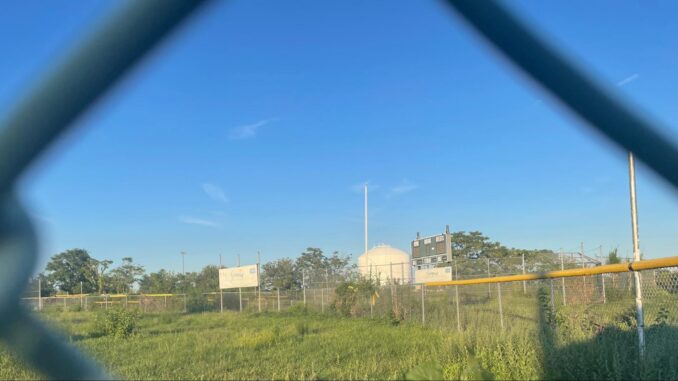
BY AMIRA TURNER
Though the quiet streets of Greenpoint Brooklyn can often feel like an escape from the hustle and bustle of the big city, its residents aren’t free from the side effects of big city life. National Grid, a British-based gas company that provides utilities to all of New York City, operates a 120-acre energy storage depot in the middle of Greenpoint, the largest fossil fuel facility in New York City. This is something Sane Energy Project, an environmental non-profit, hopes to put an end to, raising awareness through walking tours.
Sane Energy Project is a grassroots organization, founded in 2011, that campaigns to stop fossil fuel projects across the city. Their successes include stopping the Williams Pipeline three years in a row, as well as the North Brooklyn Pipeline, preventing fracked gas from running through Brooklyn.
Regularly, Sane Energy Project co-director Kim Fraczek leads small groups of about 12 on half-mile walking tours from Greenpoint local parks, walking around the perimeter of the energy depot to inform environmentalists and locals alike about Sane Energy Project’s concerns. “We believe energy is a human right, and health is a human right,” Fraczek said, but she charges that National Grid’s gas infrastructure is an impediment to this.
Fraczek’s current goal with Sane Energy Project is to advocate for the shutting down of the National Grid’s Greenpoint energy depot, which currently stores and compresses liquified natural gas. According to the U.S. Department of Energy, LNG has to be stored at minus 260 degrees Fahrenheit. Sane Energy Project believes this is a waste of energy that could be used in other ways to reduce the city’s environmental impact and lessen reliance on fossil fuels. “We can do a solar project there. We can do a geothermal hub here and have it be like a multi-use facility. It’s so much land,” Fraczek said, adding, “The energy that’s happening at this facility is super toxic, just completely unsustainable.”
National Grid’s media representative, Karen Young, did not respond to these claims from Sane Energy Project.
Fraczek also uses the walking tours to gain input from locals, like lifelong Greenpoint resident Vinny, who can still recall a time before National Grid. “It used to be bustling with kids and families,” recalled Vinny, who didn’t give his last name, pointing through the gates to the Greenpoint Little League fields. Though the land is now part of National Grid’s private property, and fenced in, the original signs and scoreboards still remain.
Fraczek believes that people like Vinny should get a say in how the city uses the 120 acres of land if National Grid were to ever shut down the facility. “The reason that we’re doing these walking tours is we want to hear from the people that live here. What would you want to see on this land, besides this toxic facility,” she said. Sane Energy Project collects community testimonies like Vinny’s to present to Brooklyn Community Board 1.
Though Fraczek admits that Sane Energy Project’s fight against National Grid has been an uphill battle, she remains optimistic that change will come for Greenpoint. “We’ve been successful in New York State in the last 13 years, shutting down 10 future fossil fuel pipeline projects, so I know this one is just going to be a bear, but we’re gonna do it,” she said.
